Features
Nadungamuwe Raja, a prisoner of culture, an ambassador of culture or rather, an ambassador of conservation?

By Manasee Weerathunga
It is no doubt that the passing away of the ceremonial tusker Nadungamuwe Raja was sorrowful news to the entire country, regardless of religions and ethnicities. It is highly unlikely that there could have been any Sri Lankan who did not love this gentle giant for his majesty and tranquility. However, the question at which everyone who loved Nadungamuwe Raja becomes divided, is on whether Nadungamuwe Raja lived a life of grandeur or a life of suffering?
Nadungamuwe Raja is best known as the ceremonial tusker, bearing the main casket of the Tooth Relic of Lord Buddha in the annual procession of Esala, in Kandy, Sri Lanka. As in ancient traditions, it is only a male tusker of remarkable physique that is eligible for bearing the casket of the Tooth Relic. It is this majesty of this beast which prompted many Sri Lankans, especially the devout Buddhists, to place Nadungamuwe Raja, up on a pedestal of sanctitude. In the eyes of devout Buddhists, Nadungamuwe Raja was not only privileged enough to bear the casket of the Tooth Relic of Lord Buddha (something which is not approachable to a layman) but also was able to gather a plethora of merit in this lifetime, for the rest of Samsara, by being in service to the Lord Buddha. However, in the eyes of animal lovers and workers for animal rights, Nadungamuwe Raja was a prisoner of culture and blind religious devoutation, having had lived a life, chained in a domestic setting with no access to the natural habitat of an elephant or its co-inhabitants.
The opulent pair of long, intersecting pair of tusks can be named as the crowning glory of Nadungamuwe Raja, not to mention that he was the tallest domestic elephant known in whole Asia. In addition to these unmistaken resplendent features of Nadungamuwe Raja, the placidity of this beast’s nature, points out some facts noteworthy about elephants. Asian elephants, the species to which Nadungamuwe Raja belongs, differ from their African elephant cousins, with respect to several features. Firstly, Asian elephants are of significantly smaller build in comparison to African elephants, which makes the height of Nadungamuwe Raja, remarkable. Secondly, unlike the African elephant, which possesses tusks in both male and female alike, tusks are a rarity found in some male Asian elephants only, ticking off another box for Nadungamuwe Raja’s exceptionality. Thirdly, domesticated African elephants are unheard of because they do not share the serene demeanor of their Asian counterparts, while Nadungamuwe Raja is only one of the many domestic Asian elephants found in several countries of Asia.
However, domestication of animals is not something which is discrete for a region of the world. The history of animal domestication spans as far as the beginning of human civilization. The pre-historic man of Stone Age was in the habit of chasing and hunting the animals they wanted to fulfill their food requirements, and then moving to a new location once he had exploited all the animals in his surrounding location. However, as the humans moved on to the farming age by growing their food in their locality and forming permanent settlements, they realized that rather than going in search of animals to hunt, holding the animals in captivity, raring them and harvesting the milk, meat and hides that they needed was an easier option. That marked the beginning of animal domestication, resulting in some animal species, such as dogs, cats and ornamental fish breeds, to become fully domesticated species by the present times. A major step in this process involved identifying animals who were passive enough to be approached, caught, and held captive and tamed. This has resulted in the evolution of most domestic animal species to have traits that would make them better suited to a domestic setting while wiping out the traits which would help them survive in the wild. For example, evolution has taken away from the dogs, the traits of aggression shown by their distant relatives, the wolves, as well as any skills of surviving in the wild by hunting and avoiding predation. Therefore, if an enthusiast of animal rights is to argue that holding a gold fish in a fish tank is a violation of its rights and that it would be better off swimming freely in a stream, it is going to be one of the most frivolous points to make because a gold fish would hardly survive in a wild stream for more than 24 hours without getting predated. That is because the ancestors of these domestic animals, running back to hundreds of generations, have not even seen a wild environment so that their genes no longer contain the traits suited for the wild.
However, we cannot say the same about Asian elephants so confidently, because elephants still do exist in the wild and therefore is not a completely domesticated animal species. While the harsher environment that African elephants inhabit has made them more aggressive and violent by their genetic makeup, Asian elephants are more approachable which has enabled many countries to domesticate Asian elephants for centuries. Therefore, a fair number of domestic Asian elephants, found in many countries, are elephants who had been born and bred in domestic settings for generations. Hence, although many activists for animals rights have been voicing out in social media platforms that Nadungamuwe Raja lived a life of suffering by being chained in a domestic setting, having been an elephant born in a domestic elephant stable in India, it is uncertain what percentage of Nadungamuwe’s Raja’s genes still retained the traits that would help him survive in the wild. Usually, several generations of inbreeding of domesticated animals result in establishment of gene combinations best suited for domestic settings and purging those suited for wild environments. Still, it is uncertain how rapidly it happens in each species. With evolutionary biologists and behavioural scientists worldwide conducting a plethora of research on the question of whether nature or nurture determines the behavioural traits of an animal, the question of whether Nadungamuwe Raja would have been happier roaming freely in the wild remains an open question, with not enough data on how much of wild traits that he retained in his genes.
Nevertheless, if we were to assume that Nadungamuwe Raja was still biologically fully capable of living in a wild environment, we should not forget that he would be living in an environment where the humans have become a major predator for elephants. Evolution being a very slow process that takes millions of years, usually the genetic makeup that currently exists in many organisms is the genetic combination that evolved to suit the environmental conditions that existed thousands of years ago. The genome of many organisms is still undergoing the process of adapting to the current environment, which has changed rapidly from what it was a few hundreds of years back. Therefore, organisms do not evolve adaptations to match the changing environmental conditions as rapidly as the environment changes. The same is true for elephants because their genetic makeup has not evolved to keep up with the rapidly changing environment and hence, lack the adaptations to survive the threats posed by their greatest predator of the current world, the human. Therefore, it is fairly agreeable if someone says that Nadungamuwe Raja could have been poached long ago for his magnificent pair of tusks or could have been killed by ‘hakka patas’ traps if it had not lived in the seclusion of a domestic environment. However, it should be noted that Nadungamuwe Raja lived the average lifespan of an Asian elephant. The most common natural cause of death for wild elephants is a mechanical cause resulting from the loss of teeth. Elephants usually have four sets of teeth during their course of life and once the last set of teeth is lost, elephants die a slow and painful death due to the inability to feed and nourish themselves. It is noteworthy that the owners of Nadungamuwe Raja took the utmost effort to preserve the last set of teeth of the elephant so that his lifespan could be prolonged, by meticulously managing the elephant’s diet and behaviour. However, whether living in a natural environment and choosing his own diet from natural sources could have prolonged the lifespan of the elephant is contentious.
The increasing rarity of tusks as sumptuous as Nadungamuwe Raja’s in Asian elephants itself signals an evolutionary trend of elephants towards adaptation to the hostility created in wild environments by humans. It is the general trend of evolution to get rid of any traits that would pose a threat to the survival and fitness of any organism. By evolution, tusks serve the purpose of attracting female mates to male elephants, while helping males with combat with other males for territory and mates as well as obtaining food. With humans as a predator of elephants in wild environments, tusks have unfortunately become the worst nightmare for the survival of elephants in the wild. It is highly probable that the tusks of Nadungamuwe Raja could have brought the same unfortunate fate on him if he had lived in the wild. Even with living a domesticated life, the tusks of Nadungamuwe Raja had been too heavy for his head to bear towards the latter part of his life, although the situation had been ameliorated by his owners by arranging a sleeping place for the elephant where he could rest his head above his body. However, it is doubtful whether the tusks of Nadungamuwe Raja would have grown to that length and weight if it had lived in the wild. If a wild elephant had tusks as long and big as that, it goes without saying that it would pose a hinderance and a danger to the movement of the animal in dense vegetation, which are the common habitats of Asian elephants. Therefore, wild elephants have the habit of wearing off their tusks by rubbing them against tree branches, while the tusks of wild elephants are subjected to breakage during combats between males. For example, Gemunu, who is a well-known tusker inhabiting the Yala National Park of Sri Lanka, had only one tusk until recently, with the other being broken off during a dual. The remaining tusk was also broken off a couple of years earlier, during a dual with Nandimitra, another male elephant of the Yala National Park. Usually, once a male elephant loses his tusks in a combat, it either dies of the wounds of the combat or lives a quiet and short life restricted of mates or food of the territory, without the advantage of tusks. Therefore, another open question remains of whether Nadungamuwe Raja would have had such a luxurious pair of tusks until the end of his lifetime, had he lived in a wild environment.
Considering all these whether Nadungamuwe Raja was a prisoner of culture or not remains a question to be answered based on each person’s own morals and judgment. But, while dividing into sides and splitting hairs to prove whether Nadungamuwe Raja lived a life of a prisoner or that of royalty, there is a fact that many forget. While limiting the discussions about Nadungamuwe Raja to decorating him as an icon of Sri Lankan culture or fighting for his rights for a free life, we forget that not only Nadungamuwe Raja but all other domestic elephants of Sri Lanka which are treated with high esteem can serve a bigger role as ambassadors of environmental conservation. Nadungamuwe Raja and all other celebrated domestic elephants of Sri Lanka such as Kataragama Wasana, Indi Raja, Miyan Raja etc. fit perfectly well to the category of Flagship Species. The concept of Flagship Species introduced by the International Union for Conservation of Nature (IUCN) includes organisms having an aesthetic importance while representing a certain habitat, issue, or environmental cause. The objective of this concept is by conserving and drawing public attention to these animals which are of aesthetic attraction, the entire habitat they represent will be conserved and the environmental issue that they are involved in would be resolved. The giant panda endemic to China is an ideal example of a flagship species being a successful ambassador in resolving a conservation issue. With the giant panda being categorized as an endangered species by the IUCN in the 1980s, a massive campaign was launched to save China’s beloved national icon. This involved not only in-situ conservation efforts such as setting up nature reserve areas habitable for pandas, but also numerous ex-situ conservation techniques such as breeding pandas in captivity and propagating public interest and awareness on these cute creatures with the use of domesticated pandas held in captivity. These pandas did their job as environmental ambassadors so perfectly that by 2016, IUCN declared that giant pandas are no longer endangered but just vulnerable.
Right now, the number of Sri Lankans who worship Nadungamuwe Raja, holding him at a highly revered position is countless. Similarly, the number of Sri Lankans who fight for animal rights pointing out that Nadungamuwe Raja spent a torturous, miserable life is also fairly high. Amidst all that clamour, the number of elephants killed each year by poachers or by ‘hakka patas’ traps, the number of elephants shot by villagers for encroaching into cultivated lands, the number elephants hit by trains, plus the number of human lives lost each year by wild elephant attacks remain escalating. This disturbing trend signals to us that right now the most serious issue regarding elephants in Sri Lanka is not the debate of whether domestic elephants are cultural icons or prisoners of culture, but the human-elephant conflict which has gone unresolved, yet escalating to an extremely unfortunate level, for the past years. Wild elephants cannot be blamed for the circumstances considering the plight they are in with the construction of motorways fragmenting natural habitats of elephants and blocking their passes, human encroachment into natural habitats limiting the availability of food, water and space for the elephants plus poaching for ivory. On the other hand, the retaliation by humans to wild elephants is also fair considering the threat to property and lives it poses and the economic and emotional turmoil it costs when living in an area of wild elephant threat. That is why Nadungamuwe Raja and his fellow domestic elephants, should be viewed as ambassadors of environmental conservation rather than either icons or prisoners of culture. While thousands of people have been coming to pay their last respects to Nadungamuwe Raja with heavy hearts, while the authorities are taking steps to preserve Nadungamuwe Raja as a national treasure, while Nadungamuwe Raja’s predecessor tusker Raja has a museum dedicated all to himself and preserved and displayed as a national treasure, and while animal rights activists are launching heated social media campaigns to free the domestic elephants from their chains, there are numerous elephants in the island who portray major conservation issues. The wild elephant Natta Kota who roams the premises of tourist hotels bordering the Yala national park, has become a scavenger on garbage of the hotels which lure him to be a tourist attraction. The elephants inhabiting the forests bordering motorways of areas such as Habarana and Buttala had fallen to the plight of mafia gangsters who don’t let vehicles pass unless they are given the ransom of food. The elephants scavenging on garbage dumps of Tissamaharama have fallen to the plight of homeless beggars, picking through trash to fill their stomachs.
It goes without saying that Nadungamuwe Raja is a national treasure because a tusker of that stature and physique is indeed an asset to any country’s natural resource chest. But the reverence shown towards this animal needs to be extended to countless other elephants in Sri Lanka who are at the risk of getting poached for ivory, or killed by traps. As good as it is that Nadungamuwe Raja’s body be preserved as a national treasure as that of Raja, by housing it in a museum as a mere icon of cultural importance, the natural homes of the wild elephants of Sri Lanka needs to be preserved as well, as elephants are assets of Sri Lanka. The activists and enthusiasts of animal rights who voice out protests on the chained life that Nadungamuwe Raja led, should extend their fighting towards winning freedom for the numerous unnamed wild elephants who cannot roam wherever they wish in their native habitats and eat as much natural food as they like. Therefore, it is high time that the authorities start hailing Nandungamuwe Raja as an icon of conservational importance, rather than as a mere national treasure of cultural importance while the worshippers of Nandungamuwe Raja and the fighters for Nandungamuwe Raja’s animal rights start portraying him as an ambassador of environmental conservation rather than an ambassador of culture or a prisoner of culture.
(The writer is a PhD Student in Evolutionary Biology, University of Florida, Gainesville, US. She thanks Gihan Athapaththu, former Naturalist at Jetwing Yala, currently Master’s student at Jeju National University, South Korea, for his contribution to this article.)
Features
Wishes, Resolutions and Climate Change

Exchanging greetings and resolving to do something positive in the coming year certainly create an uplifting atmosphere. Unfortunately, their effects wear off within the first couple of weeks, and most of the resolutions are forgotten for good. However, this time around, we must be different, because the nation is coming out of the most devastating natural disaster ever faced, the results of which will impact everyone for many years to come. Let us wish that we as a nation will have the courage and wisdom to resolve to do the right things that will make a difference in our lives now and prepare for the future. The truth is that future is going to be challenging for tropical islands like ours.
We must not have any doubts about global warming phenomenon and its impact on local weather patterns. Over its 4.5-billion-year history, the earth has experienced drastic climate changes, but it has settled into a somewhat moderate condition characterised by periods of glaciation and retreat over the last million years. Note that anatomically modern Homo sapiens have been around only for two to three hundred thousand years, and it is reasoned that this stable climate may have helped their civilisation. There have been five glaciation periods over the last five hundred thousand years, and these roughly hundred-thousand-year cycles are explained by the astronomical phenomenon known as the Milankovitch Cycle (the lows marked with stars in Figure 1). At present, the earth is in an inter glacial period and the next glaciation period will be in about eighty thousand years.
 (See Figure 1. Glaciation Cycles)
(See Figure 1. Glaciation Cycles)
During these cycles, the global mean temperature has changed by about 7-8 degrees Centigrade. In contrast to this natural variation, earth has been experiencing a rapid temperature increase over the past hundred years. There is ample scientific evidence from multiple sources that this is caused by the increase in carbon dioxide gas in the atmosphere, which has seen a 50% increase over the historical levels in just hundred years (Figure 2). Carbon dioxide is one of the greenhouse gases which traps heat from the sun and slows the natural cooling process of the earth. This increase of carbon dioxide is due to human activities: fossil fuel burning, industrial processes, deforestation, and agricultural practices. Ironically, those who suffer from the consequences did not contribute to these changes; those who did contribute are trying their best to convince the world that the temperature changes we see are natural, and nothing should be done. We must have no illusions that global warming is a human-caused phenomenon, and it has serious repercussions.

(See Figure 2. Global Temperature and Carbon Dioxide Levels)
Why should we care about global warming? Well, there are many reasons, but let us focus on earth’s water cycle. Middle schoolers know that water evaporates from the oceans, rises into the atmosphere where it cools, condenses, and falls back onto earth as rain or snow. When the oceans warm, the evaporation increases, and the warmer atmosphere can hold more water vapour. Water laden atmosphere results in severe and erratic weather. Ironically, water vapour is also a greenhouse gas, and this has a snowballing effect. The increased ocean temperature also disrupts ocean currents that influence the weather on land. The combined result is extreme and severe weather: violent storms and droughts depending on the geographic location. What is happening on the West coast of the USA is an example. The net result will be major departures from what is considered normal weather over millennia.
International organisations have been talking for 30 years about limiting global temperature increase to 1.5oC above pre-industrial levels by curtailing greenhouse gas emissions. But not much has been done and the temperature has risen by 1.2oC already. The challenge is that even if we can stop greenhouse gas emissions completely, right now, we have the problem of removing already existing 2,500 billion tons of carbon from the atmosphere, for which there are no practical solutions yet. Scientists worry about the consequences of runaway temperature increase and its effect on human life, which are many. It is not a doomsday prediction of life disappearing from earth, but a warning that life will be quite different from what humans are used to. All small tropical nations like ours are burdened with mitigating the consequences; in other words, get ready for more Ditwahs, do not wait for the twelve-day forecast.
Some opined that not enough warning was given regarding Ditwah; the truth is that the tools available for long-term prediction of the path or severity of a weather event (cyclone, typhoon, hurricane, tornado) are not perfect. There are multitude of rapidly changing factors contributing to the behavior of weather events. Meteorologists feed most up to date data to different computer models and try to identify the prediction with the highest probability. The multiple predictions for the same weather event are represented by what is known as spaghetti plots. Figure 3 shows the forecasted paths of a 2019 Atlantic hurricane five days ahead on the right and the actual path it followed on the left. While the long-term prediction of the path of a cyclone remains less accurate, its strength can vary within hours. There are several Indian ocean cyclones tracking sites online accessible to the public.

Figure 3. Forecasting vs Reality
There is no argument that short-term forecasts of this nature are valuable in saving lives and movable assets, but having long term plans in place to mitigate the effects of natural disasters is much more important than that. If a sizable section of the population must start over their lives from ground zero after every storm, how can a country economically develop?
The degree of our unpreparedness came to light during Ditwah disaster. It is not for lack of awareness; judging by the deluge of newspaper articles, blogs, vlogs, and speeches made, there is no shortage of knowledge and technical expertise to meet the challenge. The government has assured the necessary resources, and there is good reason to trust that the funds will be spent properly and not to line the pockets as happened during previous disasters. However, history tells us that despite the right conditions and good intentions, we could miss the opportunity again. Reasons for such skepticisms emerged during the few meetings the President held with the bureaucrats while visiting effected areas. Also, the COPE committee meetings plainly display the inherent inefficiencies and irregularities of our system and the absence of work ethics among all levels of the bureaucracy.
What it tells us is that we as a nation have an attitude problem. There are ample scholarly analyses by local as well as international researchers on this aspect of Sri Lankan psyche, and they label it as either island or colonial mentality. The first refers to the notion of isolated communities perceiving themselves as exceptional or superior to the rest of the world, and that the world is hell-bent on destroying or acquiring what they have. This attitude is exacerbated by the colonial mentality that promoted the divide and conquer rules and applied it to every societal characteristic imaginable; and plundered natural resources. As a result, now we are divided along ethnic, linguistic, religious, political, class, caste, geography, wealth, and many more real and imagined lines. Sadly, politicians, some religious leaders, and other opportunists keep inflaming these sentiments for their benefit when most of the population is willing to move on.
The first wish, therefore, is to get the strength, courage, and wisdom to think rationally, and discard outdated and outmoded belief systems that hinder our progress as a nation. May we get the courage to stop venerating elite who got there by exploiting the masses and the country’s wealth. More importantly, may we get the wisdom to educate the next generation to be free thinkers, give them the power and freedom to reject fabrications, myths, and beliefs that are not based on objective facts.
This necessitates altering our attitude towards many aspects of life. There is no doubt that free thinking does not come easily, it involves the proverbial ‘exterminating the consecrated bull.’ We are rightfully proud about our resplendent past. It is true that hydraulic engineering, art, and architecture flourished during the Anuradhapura period.
However, for one reason or another, we have lost those skills. Nowadays, all irrigation projects are done with foreign aid and assistance. The numerous replicas of the Avukana statue made with the help of modern technology, for example, cannot hold a candle to the real one. The fabled flying machine of Ravana is a figment of marvelous imagination of a skilled poet. Reality is that today we are a nation struggling with both natural and human-caused disasters, and dependent on the generosity of other nations, especially our gracious neighbor. Past glory is of little help in solving today’s problems.
Next comes national unity. Our society is so fragmented that no matter how beneficial a policy or an idea for the nation could be, some factions will oppose it, not based on facts, but by giving into propaganda created for selfish purposes. The island mentality is so pervasive, we fail to trust and respect fellow citizens, not to mention the government. The result is absence of long-term planning and stability. May we get the insight to separate policy from politics; to put nation first instead of our own little clan, or personal gains.
With increasing population and decreasing livable and arable land area, a national land management system becomes crucial. We must have an intelligent zoning system to prevent uncontrolled development. Should we allow building along waterways, on wetlands, and road easements? Should we not put the burden of risk on the risk takers using an insurance system instead of perpetual public aid programs? We have lost over 95% of the forest cover we had before European occupation. Forests function as water reservoirs that release rainwater gradually while reducing soil erosion and stabilizing land, unlike monocultures covering the hill country, the catchments of many rivers. Should we continue to allow uncontrolled encroachment of forests for tourism, religious, or industrial purposes, not to mention personal enjoyment of the elite? Is our use of land for agricultural purposes in keeping with changing global markets and local labor demands? Is haphazard subsistence farming viable? What would be the impact of sea level rising on waterways in low lying areas?
These are only a few aspects that future generations will have to grapple with in mitigating the consequences of worsening climate conditions. We cannot ignore the fact that weather patterns will be erratic and severe, and that will be the new normal. Survival under such conditions involves rational thinking, objective fact based planning, and systematic execution with long term nation interests in mind. That cannot be achieved with hanging onto outdated and outmoded beliefs, rituals, and traditions. Weather changes are not caused by divine interventions or planetary alignments as claimed by astrologers. Let us resolve to lay the foundation for bringing up the next generation that is capable of rational thinking and be different from their predecessors, in a better way.
by Geewananda Gunawardana
Features
From Diyabariya to Duberria: Lanka’s Forgotten Footprint in Global Science

For centuries, Sri Lanka’s biological knowledge travelled the world — anonymously. Embedded deep within the pages of European natural history books, Sinhala words were copied, distorted and repurposed, eventually fossilising into Latinised scientific names of snakes, bats and crops found thousands of kilometres away.
Africa’s reptiles, Europe’s taxonomic catalogues and global field guides still carry those echoes, largely unnoticed and uncredited.
Now, a Sri Lankan herpetologist is tracing those forgotten linguistic footprints back to their source.
Through painstaking archival research into 17th- and 18th-century zoological texts, herpetologist and taxonomic researcher Sanjaya Bandara has uncovered compelling evidence that several globally recognised scientific names — long assumed to be derived from Greek or Latin — are in fact rooted in Sinhala vernacular terms used by villagers, farmers and hunters in pre-colonial Sri Lanka.
“Scientific names are not just labels. They are stories,” Bandara told The Island. “And in many cases, those stories begin right here in Sri Lanka.”

Sanjaya Bandara
At the heart of Bandara’s work is etymology — the study of word origins — a field that plays a crucial role in zoology and taxonomy.
While classical languages dominate scientific nomenclature, his findings reveal that Sinhala words were quietly embedded in the foundations of modern biological classification as early as the 1700s.
One of the most striking examples is Ahaetulla, the genus name for Asian vine snakes. “The word Ahaetulla is not Greek or Latin at all,” Bandara explained. “It comes directly from the Sinhala vernacular used by locals for the Green Vine Snake.” Remarkably, the term was adopted by Carl Linnaeus himself, the father of modern taxonomy.
Another example lies in the vespertilionid bat genus Kerivoula, described by British zoologist John Edward Gray. Bandara notes that the name is a combination of the Sinhala words kiri (milky) and voula (bat). Even the scientific name of finger millet, Eleusine coracana, carries linguistic traces of the Sinhala word kurakkan, a cereal cultivated in Sri Lanka for centuries.
Yet Bandara’s most intriguing discoveries extend far beyond the island — all the way to Africa and the Mediterranean.
In a research paper recently published in the journal Bionomina, Bandara presented evidence that two well-known snake genera, Duberria and Malpolon, both described in 1826 by Austrian zoologist Leopold Fitzinger, likely originated from Sinhala words.
The name Duberria first appeared in Robert Knox’s 1681 account of Ceylon, where Knox refers to harmless water snakes called “Duberria” by locals. According to Bandara, this was a mispronunciation of Diyabariya, the Sinhala term for water snakes.
“Mispronunciations are common in Knox’s writings,” Bandara said. “English authors of the time struggled with Sinhala phonetics, and distorted versions of local names entered European literature.”
Over time, these distortions became formalised. Today, Duberria refers to African slug-eating snakes — a genus geographically distant, yet linguistically tethered to Sri Lanka.
Bandara’s study also proposes the long-overdue designation of a type species for the genus, reviving a 222-year-old scientific name in the process.
Equally compelling is the case of Malpolon, the genus of Montpellier snakes found across North Africa, the Middle East and southern Europe. Bandara traced the word back to a 1693 work by English zoologist John Ray, which catalogued snakes from Dutch India — including Sri Lanka.
“The term Malpolon appears alongside Sinhala vernacular names,” Bandara noted. “It is highly likely derived from Mal Polonga, meaning ‘flowery viper’.” Even today, some Sri Lankan communities use Mal Polonga to describe patterned snakes such as the Russell’s Wolf Snake.
Bandara’s research further reveals Sinhala roots in the African Red-lipped Herald Snake (Crotaphopeltis hotamboeia), whose species name likely stems from Hothambaya, a regional Sinhala term for mongooses and palm civets.
“These findings collectively show that Sri Lanka was not just a source of specimens, but a source of knowledge,” Bandara said. “Early European naturalists relied heavily on local names, local guides and local ecological understanding.”
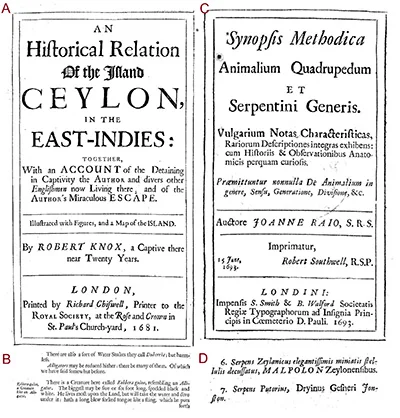 Perhaps the most frequently asked question Bandara encounters concerns the mighty Anaconda. While not a scientific name, the word itself is widely believed to be a corruption of the Sinhala Henakandaya, another snake name recorded in Ray’s listings of Sri Lankan reptiles.
Perhaps the most frequently asked question Bandara encounters concerns the mighty Anaconda. While not a scientific name, the word itself is widely believed to be a corruption of the Sinhala Henakandaya, another snake name recorded in Ray’s listings of Sri Lankan reptiles.
“What is remarkable,” Bandara reflected, “is that these words travelled across continents, entered global usage, and remained there — often stripped of their original meanings.”
For Bandara, restoring those meanings is about more than taxonomy. It is about reclaiming Sri Lanka’s rightful place in the history of science.
“With this study, three more Sinhala words formally join scientific nomenclature,” he said.
“Who would have imagined that a Sinhala word would be used to name a snake in Africa?”
Long before biodiversity hotspots became buzzwords and conservation turned global, Sri Lanka’s language was already speaking through science — quietly, persistently, and across continents.
By Ifham Nizam
Features
Children first – even after a disaster

However, the children and their needs may be forgotten after a disaster.
Do not forget that children will also experience fear and distress although they may not have the capacity to express their emotions verbally. It is essential to create child-friendly spaces that allow them to cope through play, draw, and engage in supportive activities that help them process their experiences in a healthy manner.
The Institute for Research & Development in Health & Social Care (IRD), Sri Lanka launched the campaign, titled “Children first,” after the 2004 Tsunami, based on the fundamental principle of not to medicalise the distress but help to normalise it.
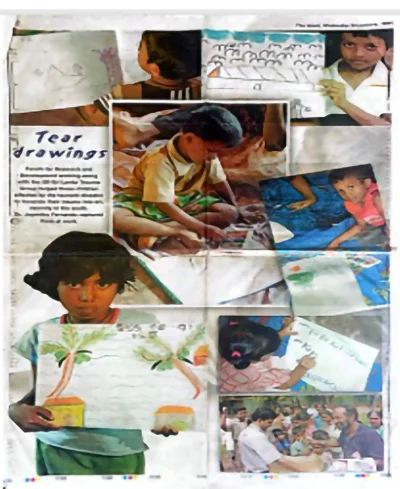
The Island picture page
The IRD distributed drawing material and play material to children in makeshift shelters. Some children grabbed drawing material, but some took away play material. Those who choose drawing material, drew in different camps, remarkably similar pictures; “how the tidal wave came”.
“The Island” supported the campaign generously, realising the potential impact of it.
The campaign became a popular and effective public health intervention.
“A public health intervention (PHI) is any action, policy, or programme designed to improve health outcomes at the population level. These interventions focus on preventing disease, promoting health, and protecting communities from health threats. Unlike individual healthcare interventions (treating individuals), which target personal health issues, public health interventions address collective health challenges and aim to create healthier environments for all.”
The campaign attracted highest attention of state and politicians.
The IRD continued this intervention throughout the protracted war, and during COVID-19.
The IRD quick to relaunch the “children first” campaign which once again have received proper attention by the public.
While promoting a public health approach to handling the situation, we would also like to note that there will be a significant smaller percentage of children and adolescents will develop mental health disorders or a psychiatric diagnosis.
We would like to share the scientific evidence for that, revealed through; the islandwide school survey carried out by the IRD in 2007.
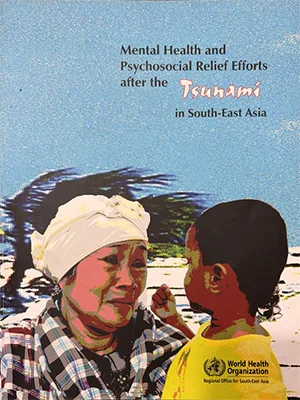 During the survey, it was found that the prevalence of emotional disorder was 2.7%, conduct disorder 5.8%, hyperactivity disorder was 0.6%, and 8.5% were identified as having other psychiatric disorders. Absenteeism was present in 26.8%. Overall, previous exposure to was significantly associated with absenteeism whereas exposure to conflict was not, although some specific conflict-related exposures were significant risk factors. Mental disorder was strongly associated with absenteeism but did not account for its association with tsunami or conflict exposure.
During the survey, it was found that the prevalence of emotional disorder was 2.7%, conduct disorder 5.8%, hyperactivity disorder was 0.6%, and 8.5% were identified as having other psychiatric disorders. Absenteeism was present in 26.8%. Overall, previous exposure to was significantly associated with absenteeism whereas exposure to conflict was not, although some specific conflict-related exposures were significant risk factors. Mental disorder was strongly associated with absenteeism but did not account for its association with tsunami or conflict exposure.
The authors concluded that exposure to traumatic events may have a detrimental effect on subsequent school attendance. This may give rise to perpetuating socioeconomic inequality and needs further research to inform policy and intervention.
Even though, this small but significant percentage of children with psychiatric disorders will need specialist interventions, psychological treatment more than medication. Some of these children may complain of abdominal pain and headaches or other physical symptoms for which doctors will not be able to find a diagnosable medical cause. They are called “medically unexplained symptoms” or “somatization” or “bodily distress disorder”.
Sri Lanka has only a handful of specialists in child and adolescent psychiatric disorders but have adult psychiatrists who have enough experience in supervising care for such needy children. Compared to tsunami, the numbers have gone higher from around 20 to over 100 psychiatrists.
Most importantly, children absent from schools will need more close attention by the education authorities.
In conclusion, going by the principles of research dissemination sciences, it is extremely important that the public, including teachers and others providing social care, should be aware that the impact of Cyclone Ditwah, which was followed by major floods and landslides, which is a complex emergency impact, will range from normal human emotional behavioural responses to psychiatric illnesses. We should be careful not to medicalise this normal distress.
It’s crucial to recall an important statement made by the World Health Organisation following the Tsunam
Prof. Sumapthipala MBBS, DFM, MD Family Medicine, FSLCFP (SL), FRCPsych, CCST (UK), PhD (Lon)]
Director, Institute for Research and Development in Health and Social Care, Sri Lanka
Emeritus Professor of Psychiatry, School of Medicine, Faculty of Medicine & Health Sciences, Keele University, UK
Emeritus Professor of Global Mental Health, Kings College London
Secretary General, International society for Twin Studies
Visiting Professor in Psychiatry and Biomedical Research at the Faculty of Medicine, Kotelawala Defence University, Sri Lanka
Associate Editor, British Journal Psychiatry
Co-editor Ceylon Medical Journal.
Prof. Athula Sumathipala
-

 News7 days ago
News7 days agoMembers of Lankan Community in Washington D.C. donates to ‘Rebuilding Sri Lanka’ Flood Relief Fund
-

 News5 days ago
News5 days agoBritish MP calls on Foreign Secretary to expand sanction package against ‘Sri Lankan war criminals’
-

 Features7 days ago
Features7 days agoGeneral education reforms: What about language and ethnicity?
-
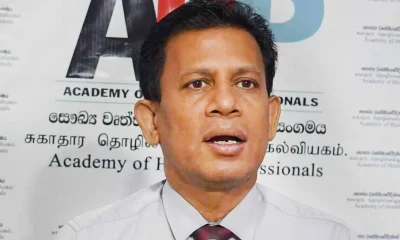
 News7 days ago
News7 days agoSuspension of Indian drug part of cover-up by NMRA: Academy of Health Professionals
-

 Sports5 days ago
Sports5 days agoChief selector’s remarks disappointing says Mickey Arthur
-
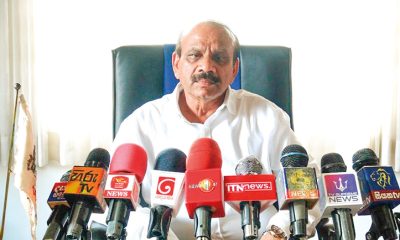
 News4 days ago
News4 days agoStreet vendors banned from Kandy City
-

 Editorial7 days ago
Editorial7 days agoA very sad day for the rule of law
-

 News7 days ago
News7 days agoUS Ambassador to Sri Lanka among 29 career diplomats recalled



















